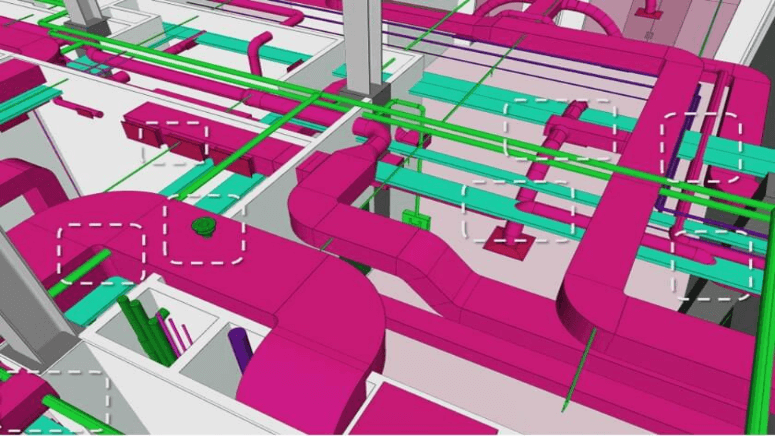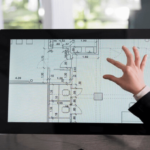MEP coordination is crucial for construction advances to generate efficiency, lower conflicts, and save costs that provide better performance, functionality, and sustainability.
Building a design that is not only functional but also an efficient structure to accommodate all the needs is a sophisticated process requiring multiple work disciplines to work together.
One of the focal points of MEP coordination is MEP, where the flow of the three major systems of the building, mechanical, electrical, and plumbing, are synchronized into one convenient system. Through the lens of this blog entry, we will go through the importance of MEP coordination in the design of buildings and how it is a success for construction projects.
What is MEP Coordination?
The coordination between MEP is the stage where the designers of mechanical, electrical, and plumbing systems are integrated and synchronized to make the building more efficient. They group these systems so that they will run without obstructions and produce the expected outcomes. MEP coordination should come to us to sort out conflicts, save costs, and increase the efficiency of the building.
Key Components of MEPF Systems
MEPF stands for Mechanical, Electrical, Plumbing, and Fire protection, which are pivotal for ensuring a building’s operational integrity and safety.
HVAC Systems (Heating, Ventilation, and Air Conditioning)
HVAC systems are fundamental to maintaining indoor comfort by changing factors such as temperature, humidity, and air quality. Appropriate management of guide HVAC systems would ensure correct energy use and the desired level of occupant comfort.
Electrical Systems
This guide for electrical drawing and system design deals with different electrical systems such as power distribution, lighting, and communication networks. MEPS, Power allocation, lighting, and communication networks are only part of electrical systems. MEP coordination is to guarantee the electrical systems are proportionally designed, situated, and integrated with other building systems to make conflicts of sharing and safe and reliable operation.
Water Supply Systems
Water supply systems include plumbing fixtures, piping, and equipment for distributing potable water and removing wastewater. MEP coordination is crucial to ensure water supply systems are appropriately sized, located, and connected to avoid leaks, clogs, and other issues.
Fire Protection Systems
Fire detection and, if needed, control systems play a vital role in fire protection, and this includes sprinklers, fire alarms, and smoke management systems. The conferencing of MEP means that these systems are correctly connected with other building systems and comply with local building laws and guidelines.
Common Challenges in MEP BIM Coordinator
The coordination of MEPs is often tricky because of the complexity and interconnection of the building systems. Some common challenges include:
- Lack of space for machines and amenities.
- Conflicts between different systems (shifting of ductwork, plumbing, and HVAC system)
- Communication between the disciplines
- Changes in design during the construction process
- Lack of record keeping and sharing of information
MEP Coordination Process: Typical Stages in MEP Coordination
The MEP coordination process typically involves several key stages, each critical to ensuring a streamlined and efficient mechanical, electrical, and plumbing system integration.
Project Initiation
Since the MEP coordination process is the first step, project goals, scope, and specifications are being determined, followed by MEP coordination. One of the first steps is to pinpoint the main stakeholders and make a perfect communication plan to operate through the following stages.
Develop a BIM Execution Plan (BEP)
Based on a BIM Execution Plan specifying the roles, responsibilities, level of detail for each building system, and the procedures for data interoperability and cooperation, the team proceeds with the project.
MEP 3D Modeling
In the subsequent phase, the generating process is creating 3D models for different MEP systems with the help of Building Information Modeling software, for example, Autodesk Revit. These models are for the physical representation of systems layouts and functionality, enabling conflict detection.
Clash Detection and Resolution
Clash Detection software is applied to these situations to identify whether there are conflicts between different elements. Coordination meetings and subsequent updates of models then follow these consultations.
Coordination Meetings
Biannual technical management meetings are scheduled to track, discuss the difficulties, and decide on the design changes with a central coordinator.
Model Updates and Revisions
The course on the MEP models is crucial as they are change and revised along the way as the design progresses. Thus, the models never lose the slightest bit of credibility or become obsolete.
Validation and Verification
The step in MEP coordination that comes last involves triple-checking all the models to ensure they comply with the requirements and regulations of the building codes and the project goals.
Final Documentation
Lastly, in this process, once the MEP coordination has been completed, final documentation, which is composed of drawings, specifications, schedule, and so on, is produced. This document serves to strengthen the buildings.
As-Built Documentation
For the next step after the construction, the as-built documentation is prepared to follow the design and reflect the changed or modified design during the construction.
Benefits of MEP Coordination in Building Design
Effective MEP coordination offers numerous benefits, including:
- Less construction work and time were require.
- The two benefits of using an improved performance and energy efficiency system.
- Improved quality of the Inside environment and a better chance of survival in case of an accident.
- It lowered maintenance, supplies, and heating/cooling expenses.
- It enhanced cross-border communication and collaboration among disciplines.
- Listen to the given audio, where a speaker discusses the significance of higher education in shaping the career paths of young individuals. Pay attention to the tone, emphatic words, and any key points the speaker makes. Then, rewrite the audio in your own words as a sentence.
- Faster project delivery and reduced rework
Technologies for Effective MEP Coordination
Several technologies are available to support effective MEP coordination, including:
Building Information Modeling (BIM)
BIM tools can be use to make 3D models that are useful for visualization, detection, and solving clashes among different teams and individuals.
3D Laser Scanning
3D laser scanning could be highly advantageous, even when the structures are already in use, by creating precise as-built representations of the buildings for renovation and retrofit purposes.
Virtual Reality (VR) and Augmented Reality (AR)
VR and AR technologies can be use to visualize and handle the MEP models in an immersive manner, letting the designer and the design team members grasp the design better and communicate among themselves.
Cloud Collaboration
The cloud-based collaboration platform facilitates up-to-date model sharing and real-time simultaneous updates, thus allowing the off-site staff to interact and cooperate with the home office efficiently.
How MEP Coordination Can Help in a Construction Project
MEP coordination is essential for the success of MEP plans in construction projects. By identifying and resolving conflicts early in the design process, MEP coordination can help to:
- Avoid costly rework and delays during construction
- Ensure that systems are correctly size and located for optimal performance
- Improve the constructability of the design
- Facilitate communication and collaboration between disciplines
- Ensure compliance with building codes and regulations
Also read: How to Use Mechanical Drawings for Effective Construction Documentation
The Future of MEP Coordination
In the evolving technological era, MEP coordination is here to shine extensively. Some trends and innovations that are shaping the future of MEP coordination include:
- The evolution of AI and ML primarily for this purpose with automated mechanisms for clash detection and resolution
- Infusing Internet of Things (IoT) technology devices like sensors, meters, and real-time monitoring helps optimize building systems.
- An advantage is that 3D printers can be use for quick and efficient prototyping and testing of MEP components.
- Adjustment of lean construction principles for collaborative coordination of the project flow.
Conclusion
The coordinated effort of MEP is a crucial element of the building design that can become influential in the successful realization of construction projects. MEP bim coordination services is a beneficial tool for integrating, synchronizing, and harmonizing mechanical, electrical, and plumbing system designs. This, in turn, facilitates cost-cutting, enhances performance, and ensures occupant safety and comfort.
To meet the ever-increasing demands of clients and stakeholders, architects, engineers, and construction project managers should take on MEP coordination, and the latest technologies and methodologies should adopted for timely, within-budget construction and high quality standards.
As a Cad drafting service company, we provide a full suite of BIM modeling services, including MEP BIM services (and) Revit MEP BIM services, so that our clients can experience success in MEP coordination. We present our team of BIM experts with years of experience to assist in MEP coordination for technologically challenging projects by achieving success.
Our contact today will be the best way to gather more information about how we can be a part of your next building design project.




